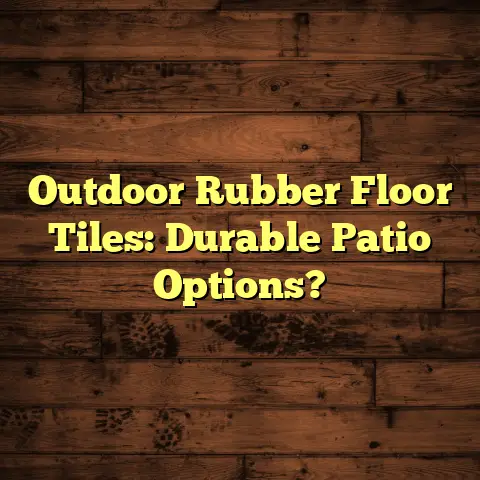Luxury Vinyl Tile Cost: Shop Smart! (9 Price Factors!)
LVT isn’t just about aesthetics; it’s a practical and, surprisingly, often sustainable choice for modern homes.
With environmental consciousness on the rise, choosing flooring that balances beauty, durability, and eco-friendliness is essential.
LVT has emerged as a frontrunner, offering not only a stunning appearance and resilience but also a more sustainable alternative to traditional options.
As consumers become increasingly eco-aware, understanding the cost implications of LVT becomes crucial for making informed decisions.
In this article, I’m going to break down the costs of Luxury Vinyl Tile and highlight the nine key price factors that can influence your purchasing journey.
Ready to dive in? Let’s get started!
Section 1: Understanding Luxury Vinyl Tile
1. Define Luxury Vinyl Tile (LVT)
So, what exactly is Luxury Vinyl Tile?
Well, LVT is a type of flooring designed to mimic the look of natural materials like hardwood, stone, or ceramic tile, but with the added benefits of vinyl.
Think of it as the chameleon of the flooring world, able to transform into almost anything you desire!
Unlike traditional sheet vinyl, LVT comes in individual tiles or planks, offering more design flexibility and a more realistic appearance.
What sets LVT apart from other flooring materials, like hardwood or laminate, is its composition.
It’s typically made of several layers, including a PVC core, a printed design layer, and a protective wear layer.
This construction makes it incredibly durable, water-resistant, and comfortable underfoot.
The technology behind LVT is pretty impressive.
The layers are fused together under heat and pressure, creating a stable and long-lasting product.
The protective coatings, often enhanced with UV inhibitors, help prevent fading and staining, ensuring your floors look great for years to come.
2. Advantages of LVT
Okay, so now that we know what LVT is, let’s talk about why it’s such a popular choice.
Here are some of the key advantages:
-
Durability and Resistance to Wear and Tear:
LVT is incredibly tough. It can handle high foot traffic, kids, pets, and all the spills and accidents that come with daily life. I’ve seen LVT floors in commercial settings that still look amazing after years of use.
-
Comfortable Underfoot and Sound-Dampening Properties:
Unlike hard tile or stone, LVT has a bit of give, making it more comfortable to walk on. Plus, it helps absorb sound, reducing noise levels in your home. Trust me, your ears will thank you!
-
Design Versatility and Aesthetic Appeal:
This is where LVT really shines.
You can find LVT in a huge range of styles, colors, and patterns, from realistic wood grains to modern geometric designs.
Whether you’re going for a rustic farmhouse look or a sleek contemporary vibe, there’s an LVT option that will fit your style.
Section 2: The Cost Breakdown of Luxury Vinyl Tile
Alright, let’s get down to the nitty-gritty: the cost!
Understanding the various factors that influence the price of LVT is crucial for making a smart purchase.
1. Material Costs
First up, let’s talk about the material costs themselves.
On average, you can expect to pay anywhere from \$2 to \$7 per square foot for LVT, depending on the quality, brand, and design.
But how does that compare to other flooring materials?
Here’s a quick breakdown:
| Flooring Material | Average Cost per Square Foot |
|---|---|
| LVT | \$2 – \$7 |
| Carpet | \$2 – \$8 |
| Hardwood | \$8 – \$25 |
| Ceramic Tile | \$3 – \$10 |
As you can see, LVT falls in the mid-range, making it a budget-friendly option compared to hardwood but potentially more expensive than basic carpet.
Keep in mind that these are just averages, and prices can vary based on your location and the specific products you choose.
2. Installation Costs
Now, let’s talk about installation. You have two options: professional installation or DIY.
Professional installation can add another \$2 to \$5 per square foot to the overall cost.
This includes the cost of labor, underlayment, and any necessary preparation work, such as leveling the subfloor.
DIY installation, on the other hand, can save you money on labor costs, but it requires time, effort, and some basic carpentry skills.
If you’re a seasoned DIYer, this might be a viable option, but if you’re not comfortable with flooring projects, I always recommend hiring a professional.
Why? Because proper installation is crucial for the longevity and performance of your LVT floor.
A poorly installed floor can lead to issues like uneven surfaces, gaps, and premature wear and tear.
Trust me; you don’t want to cut corners here!
3. Brand and Quality
Just like with any product, the brand and quality of LVT can significantly impact the price.
High-end brands like Armstrong, Shaw, and Mohawk often come with a higher price tag, but they also offer superior quality, durability, and design options.
Budget-friendly options are available from brands like TrafficMaster (Home Depot) or LifeProof (Home Depot), but keep in mind that you might be sacrificing some quality and longevity.
I always tell my clients to think about the long-term value.
Investing in a higher-quality LVT might cost more upfront, but it can save you money in the long run by lasting longer and requiring less maintenance.
4. Thickness and Wear Layer
The thickness of the tile and the wear layer are two key factors that affect both the durability and the cost of LVT.
The overall thickness of LVT typically ranges from 2mm to 8mm or more.
A thicker tile generally provides more cushioning and sound insulation, but it also comes at a higher price.
The wear layer is the top protective coating that shields the design layer from scratches, stains, and wear.
Wear layers are measured in mils (thousandths of an inch).
Residential LVT typically has a wear layer of 6 to 20 mils, while commercial-grade LVT can have a wear layer of 20 mils or more.
The thicker the wear layer, the more durable the floor and the higher the price.
For high-traffic areas like kitchens and hallways, I recommend choosing LVT with a thicker wear layer (12 mils or more) to ensure it can withstand the wear and tear.
5. Design and Style
Believe it or not, the design and style of LVT can also affect the price.
Intricate designs, textures, and colors often require more sophisticated manufacturing processes, which can drive up the cost.
For example, LVT that mimics the look of exotic hardwood or natural stone is typically more expensive than simpler, more basic designs.
Trends in LVT design can also influence costs.
Right now, wide-plank wood-look LVT and geometric patterns are very popular, and these styles might command a premium price due to high demand.
6. Underlayment and Accessories
Don’t forget about underlayment and accessories!
Underlayment is a thin layer of material that is installed beneath the LVT to provide cushioning, sound insulation, and moisture protection.
While some LVT products come with a pre-attached underlayment, others require you to purchase it separately.
Depending on the type and quality, underlayment can add another \$0.50 to \$1.50 per square foot to the overall cost.
Other accessories you might need include moldings, transitions, and adhesives.
These items can add up, so be sure to factor them into your budget.
7. Geographic Location
Here’s something you might not have considered:
Costs can vary significantly by region or city due to local market factors.
For example, labor costs tend to be higher in urban areas compared to rural areas, which can impact the overall installation cost.
The availability of certain LVT products can also vary by region, affecting the price.
In areas where demand is high and supply is limited, you might have to pay more for your LVT.
To give you an idea, I’ve seen LVT prices in California be as much as 20% higher than in some Midwestern states.
8. Warranty and Lifespan
Warranties are your safety net.
They vary among manufacturers and can range from a few years to a lifetime warranty.
Generally, the longer the warranty, the higher the price.
But think of it as an investment in peace of mind.
A good warranty can protect you against manufacturing defects, premature wear, and other issues.
The lifespan of LVT can also vary depending on the quality and how well it’s maintained.
With proper care, a high-quality LVT floor can last for 15 to 20 years or more.
Investing in a higher-priced option with a longer warranty might yield better long-term savings by reducing the need for repairs or replacements.
9. Environmental Impact and Sustainability
Last but not least, let’s talk about the environmental impact and sustainability of LVT.
More and more consumers are looking for eco-friendly flooring options, and LVT can be a sustainable choice, especially if you opt for products with sustainability certifications like FloorScore or GreenGuard.
These certifications ensure that the LVT has low volatile organic compound (VOC) emissions and is safe for indoor air quality.
Eco-friendly LVT options might come with a slightly higher price tag, but they offer long-term cost benefits by promoting a healthier indoor environment and reducing your environmental footprint.
Plus, some manufacturers use recycled materials in their LVT production, which can further enhance its sustainability.
Conclusion: Making Smart Choices
So, there you have it!
Nine key price factors to consider when shopping for Luxury Vinyl Tile.
By understanding these factors, you can shop smart and find the perfect flooring solution that meets both your budget and your environmental values.
Remember to consider material costs, installation, brand quality, thickness, design, underlayment, location, warranty, and sustainability when making your decision.
Happy flooring!





